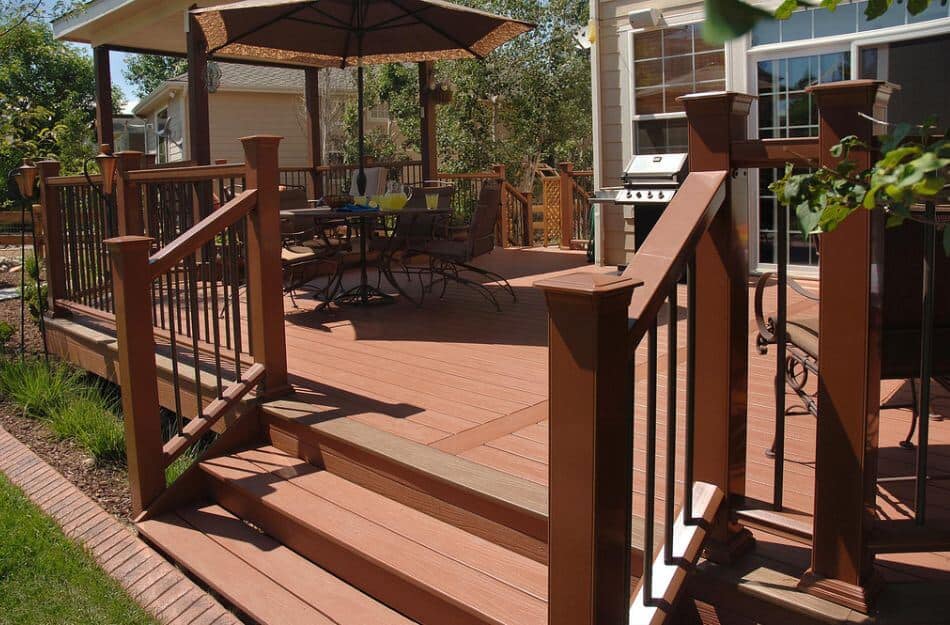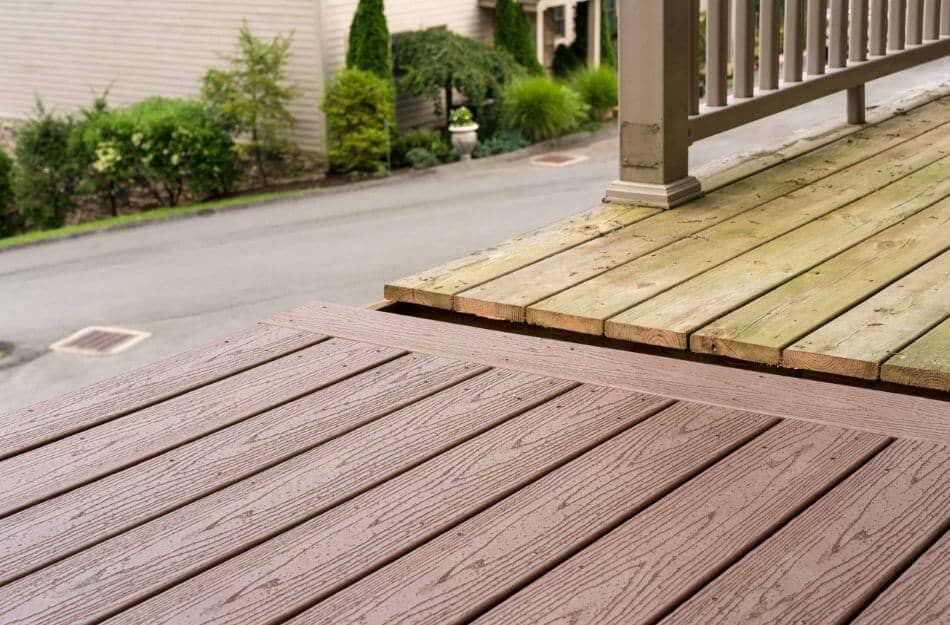Building a deck is difficult, but maintaining it is even more difficult. If you are a deck owner, you might also face an issue of water pooling on your deck if it needs to be constructed properly.
Many people are afraid of this problem even before building a deck, so how to stop water from pooling on the decking?
The best way to do so is to build either a sloped deck or a level deck with spacing between boards to allow for drainage.
These two methods will allow the water to slide off the surface and prevent it from pooling on it.

Table of Contents
What Are Sloped or Leveled Decks?
Sloped Deck
The purpose of a slope is to allow water to slip off the deck in times of rain, so you don’t have a mini pool or puddle in the center of your deck.
Not only will the rainwater make it possible for you to use the deck once cleaned, but it will also destroy the deck as it can seep into the wooden boards and cause them to crack or chip off.
Besides, the rainwater can also damage your furniture on the deck if it is allowed to stay for long.
To avoid this problem, you need to get a slope in your deck, and we’re talking about something other than the kind of slope you see when going downhill.
A minor slope ranging from an eighth of an inch to a quarter inch per foot of the length is good enough to let water slide down.
Ensure the slope is directed away from the house so you don’t have to deal with all the rainwater pouring into your doorstep.
Such a slope is not visible to the naked eye, but it is ample to prevent the water from getting stored on the surface.
Also Read: A Cheap Way To Build A Deck: Choosing The Affordable Option
Level Deck
To build a level deck, you need to provide a drainage system from which the water can fall and doesn’t get stored on the surface. You’re going to do that by leaving gaps between the boards.

Leaving just the right gap between the boards will create an easy pathway where the water can flow freely and trickle down. You would think about the structure’s strength and the base’s sturdiness.
But worry not, as the gaps are minimal and noticeable until you focus on them. Besides, the strength of your deck is based on the joist base you built on the bottom and not the strength of the boards alone.
You might wonder how the drainage system works, so allow us to explain.
By leaving a gap of around 3 to 8mm on the end and sides of the board (respectively), you create a narrow and constricted channel for water.
Remember that this measurement is approximate and might vary according to the type of wood you used and the size of your deck.
As rain falls on the boards, the water can’t stay on the board itself due to the momentum it holds from falling.
Hence, it has to move in a certain direction, and as it moves, the droplets will fall into the narrow channel that you’ve created.
Slowly, the quantity of water increases as the rain continues to pour, but the space of that channel remains the same. This creates pressure and forces the water to move along the channel.
It keeps on moving until the channel ends, and the water trickles down; in this way, your drainage system easily prevents water from staying on deck and ruining your wooden surface.
Why Is It Important To Let The Water Off The Deck?
As we discussed, letting the water stay on the deck will ruin your furniture and deck. However, there is another major reason why you need to build a drainage system.
The water can’t stand on the deck forever; it will either seep into it or evaporate into the air. However, it would be best if you leveled the ground before building your deck and a slope is directed toward the house.
If your deck is connected to your house directly, you will face the issue in another scenario. The issue is that the rainwater might start moving towards your house.
As little as the problem sounds, the magnitude is way higher than you might think. Keep on reading, and you’ll find out why.
Suppose you have 1/4″ (6mm) of rain in your area on an average rainy day. This might sound reasonable and will surely pose no threat to the walls or foundations of your house.
But if you have a deck measuring 12′ (3.6m) x 12′ (3.6m), gathering that water, the minimal 6mm rainwater turns into 75 liters of water rushing into your house.
Not only will it affect the walls and foundations, but you can also face serious issues with rooms and toilets located below the level of the doorway.
If you have a basement, the problem would be intensified by a factor of 10. Besides, a bigger deck would only mean that the water has increased.
Hence, ensuring water is kept from your deck is very important. If it does, there is a drainage or slope system to remove it from the deck and the house immediately.
Remember that any slope, below or above the ground, should be pointing away from the house under any circumstances.
Don’t Miss: Deck Posts In Concrete Or On Top? Which Is Ideal?
What Do I Do If I Have Already Built A Deck?
If you have already built a deck and don’t know what to do as you can’t reconstruct it, you can either build a roof or cover the deck when you’re not using it.

Build A Roof
A roof will be the most suitable for you if you want to prevent water from pooling on your dead-straight deck with no gaps
You can build a roof in various ways, e.g., a canopy over poles, a wooden roof, ready-made sheds, etc.
This will cover your deck from the top and protect it from direct UV rays, snowfall, and rain. However, it is still prone to water retention as all sides need to be covered.
Cover It Up
If you think building a roof is too much of a task, get a cover for your deck.
If you want to avoid risking the surface of your deck, your best solution is to cover the deck up when not using it. Please use parachute material; any other water-resistant material would be good enough.
Saw Off The Boards
Although this method requires some effort and tools, it is not exactly a reconstruction. If you have built a leveled deck but have yet to leave any space between the boards for drainage.

You can remove the boards, cut a certain measurement from all sides, and place it again.
For instance, if you need to maintain a gap of 8mm on the sides and 3mm on the ends, you can cut each board at 4mm on the sides and 1.5 mm on the ends and place them on the floor again.
This way, you would have a functional drainage system.
Wipe Off The Water
If you can’t change the board dimensions and think it would be too difficult to pull off, you can wipe the water as soon as it starts to pool.
You need to keep a vigilant eye, and it is a difficult task, especially on rainy days, but it saves your deck from getting damaged.
Sealants
- UV & Fade Resistant: UV and fade-resistant wood sealers work excellently to save the color and shine of your deck and ensure that it always looks lush despite being exposed to sunlight half of the day.
Prolonged exposure to UV rays can cause the wooden planks to dry up and lose all the necessary moisture inside them. This might make your boards stiffer than normal and prone to breaking.
- Waterproof: Waterproof wood sealers are extremely important in the rainy season. Excessive water landing on your deck can create serious problems. Firstly, the water can get stuck in the expansion room you have left for the boards, which will disable expansion and weaken the structure.
Secondly, the water can seep into the wood through the pores and cause it to swell up. This would mean that the wood has lost its strength completely and become a spongy compound that will wither very soon.
Lastly, if the water freezes in either the expansion room or inside the boards, it can cause them to break almost immediately, and your deck will be destroyed in a matter of days.
Staining
Stains are pigmented substances that protect against harsh UV rays and resist moisture.
If you want a better color and protection on your deck, you can try staining but do keep in mind that it doesn’t provide as much protection as sealants from moisture.
So, if you live in an area where humidity is high, or it is a tropical zone, you should reconsider your decision.
- Water-based stains: These are commonly used for furniture and fences but can also be used on decks. It does a great job in protection, can be applied in low temperatures, and dries up quickly. Besides, it is best recommended for rot and decay-resistant woods.
- Oil-based stains: These are highly functional as they are proposed to move into the pores of the wooden surface and form a protective layer. Although they are harder to apply than water-based stains, you will find them much more shiny and natural once they have been applied.
- Hybrid stains: These stains are a mixture of alkyd and acrylic stains and are much easier to apply than oil-based stains. Besides, they yield similar results as both stains above and are hence considered the best choice by some users.
Paints
Wood paints are among the most popular sources of protection from harsh weather conditions.

If you want your deck to retain its color, shine, and sturdiness, you must take care of it and provide it with all the necessary means to withstand thermal and seasonal changes.
Although you must wait before painting the deck, once it has dried, you shouldn’t keep it exposed to harsh weather conditions.
Not caring for your deck and leaving it be can cause it to fade, crack, wilt, or swell over time, as weather deterioration is not merciful. Using a paint can help prevent all these and increase your deck’s longevity.
Wood painting is an optimal option to protect your deck from weather degradation. It provides a considerable amount of protection from both UV rays and moisture.
It would protect your deck from constant exposure to sunlight and prevent the color from fading.
Besides, it will also protect the wooden surface from rain and snowfall and ensure that the water doesn’t seep in to destroy the surface from within.
In addition, painting your deck is also a source of adornment, and you can improve the look of your deck by painting it your desired color and making it more attractive.
Final Thoughts
It is important to save your deck from getting spoiled by water, as it can cause severe damage.
If you’ve already built your deck and can’t do anything about it, try wiping off the water when it starts to pool and getting your deck sealed for further protection.
Recent Posts
Although deck sealing may not be at the top of your summer to-do list, you shouldn’t put off a task.One such deck that channels the opposite of the lively and enjoyable vibe you want from an...
Any home would benefit from having a deck because it adds more area for socializing, relaxing, and outside activities.Garden decking that has been properly polished can be elegant and lovely. It...
